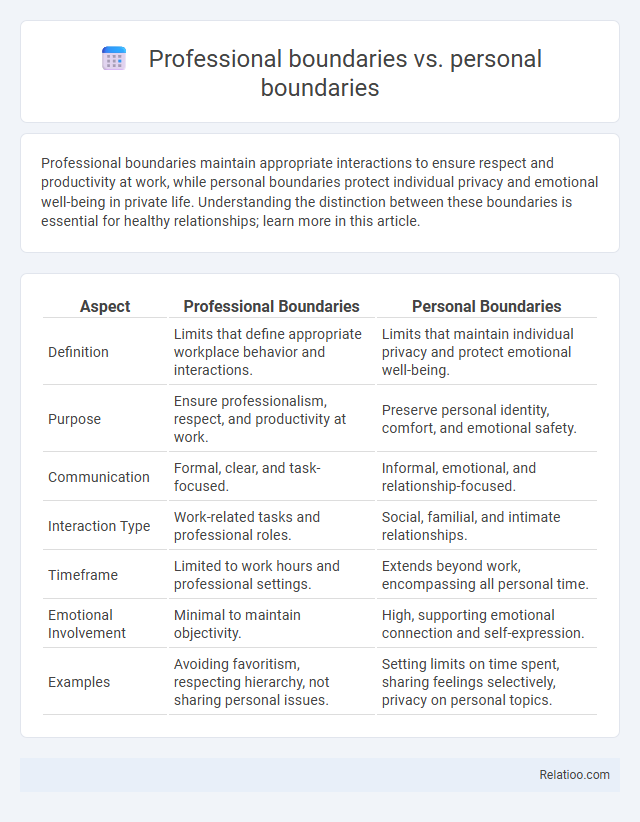Professional boundaries maintain appropriate interactions to ensure respect and productivity at work, while personal boundaries protect individual privacy and emotional well-being in private life. Understanding the distinction between these boundaries is essential for healthy relationships; learn more in this article.
Table of Comparison
| Aspect | Professional Boundaries | Personal Boundaries |
|---|---|---|
| Definition | Limits that define appropriate workplace behavior and interactions. | Limits that maintain individual privacy and protect emotional well-being. |
| Purpose | Ensure professionalism, respect, and productivity at work. | Preserve personal identity, comfort, and emotional safety. |
| Communication | Formal, clear, and task-focused. | Informal, emotional, and relationship-focused. |
| Interaction Type | Work-related tasks and professional roles. | Social, familial, and intimate relationships. |
| Timeframe | Limited to work hours and professional settings. | Extends beyond work, encompassing all personal time. |
| Emotional Involvement | Minimal to maintain objectivity. | High, supporting emotional connection and self-expression. |
| Examples | Avoiding favoritism, respecting hierarchy, not sharing personal issues. | Setting limits on time spent, sharing feelings selectively, privacy on personal topics. |
Understanding Professional Boundaries
Understanding professional boundaries is essential for maintaining respectful and effective workplace relationships, ensuring interactions remain appropriate and focused on job-related responsibilities. Professional boundaries differ from personal boundaries by emphasizing clear limits related to roles, confidentiality, and workplace ethics, protecting both parties in a professional setting. You can foster trust and a positive work environment by consistently recognizing and respecting these boundaries.
Defining Personal Boundaries
Personal boundaries refer to the limits individuals set to protect their emotional, physical, and mental well-being, distinguishing their needs and feelings from others. Defining these boundaries involves recognizing what behaviors and interactions feel comfortable or acceptable, helping maintain self-respect and personal autonomy. Unlike professional boundaries, which regulate interactions in work environments, personal boundaries govern intimate and social relationships, ensuring healthy and respectful connections.
Key Differences Between Professional and Personal Boundaries
Professional boundaries define the limits that maintain a respectful and objective relationship between you and colleagues or clients, ensuring work-related interactions remain appropriate and goal-focused. Personal boundaries, on the other hand, pertain to your emotional, physical, and psychological space outside of work, protecting your private life and personal values from unsolicited intrusion. The key difference lies in professional boundaries prioritizing workplace roles and responsibilities, while personal boundaries emphasize individual comfort and personal identity.
Importance of Maintaining Boundaries in the Workplace
Maintaining clear professional boundaries in the workplace is crucial for fostering a respectful and productive environment, preventing conflicts, and ensuring ethical interactions. Personal boundaries relate to individual comfort zones and privacy, while professional boundaries define appropriate behaviors and limits in work relationships. You protect your reputation and promote teamwork by clearly distinguishing between these types of boundaries, enhancing overall organizational harmony.
Common Scenarios of Boundary Crossings
Common scenarios of boundary crossings often involve blurring professional boundaries when personal relationships interfere with workplace roles, such as sharing confidential information or engaging in favoritism. Personal boundaries are crossed when emotional or physical limits are compromised, for example, oversharing personal issues or inappropriate physical contact with colleagues. Maintaining clear distinctions between professional and personal boundaries is crucial to prevent conflicts of interest, ensure respect, and uphold ethical standards in the workplace.
Consequences of Blurred Boundaries
Blurred boundaries between professional and personal relationships can lead to conflicts of interest, reduced productivity, and compromised decision-making in the workplace. When your professional boundaries are unclear, it increases the risk of favoritism, ethical violations, and loss of trust among colleagues and clients. Maintaining clear professional and personal boundaries protects your reputation and ensures a healthy, respectful work environment.
Strategies for Setting Professional Boundaries
Setting professional boundaries involves clear communication, consistency, and mutual respect to maintain a productive work environment. Strategies include defining roles and responsibilities explicitly, establishing availability limits, and practicing assertiveness to say no when necessary. These measures prevent burnout, reduce conflicts, and promote healthy workplace relationships without blurring into personal boundaries.
Tips for Establishing Healthy Personal Boundaries
Establishing healthy personal boundaries involves clearly defining your limits to protect your emotional well-being and maintain respectful relationships. Prioritize self-awareness by identifying your values, needs, and comfort zones to effectively communicate your boundaries to others. You can enhance your well-being by consistently reinforcing these limits and learning to say no without guilt.
Balancing Professionalism and Authenticity
Balancing professionalism and authenticity requires clear differentiation between professional boundaries, which delineate appropriate behaviors and interactions in the workplace, and personal boundaries, which protect individual emotional and physical space. Maintaining professional boundaries ensures respect and efficiency, while acknowledging personal boundaries fosters genuine connections without compromising workplace standards. Integrating both boundaries skillfully promotes a healthy work environment that supports trust, productivity, and individual well-being.
Navigating Boundary Challenges in Modern Work Environments
Navigating boundary challenges in modern work environments requires distinguishing professional boundaries, which define acceptable behaviors and interactions related to job roles, from personal boundaries that protect individual privacy and emotional well-being. Misunderstanding these boundaries can lead to conflicts, reduced productivity, and burnout, making clear communication and established policies crucial for maintaining a healthy workplace. Emphasizing respect for both professional and personal limits helps organizations foster trust, collaboration, and long-term employee satisfaction.

Infographic: Professional boundaries vs Personal boundaries
 relatioo.com
relatioo.com